Learn about our Improving the Odds for Young Children project.
Introduction
Across the U.S., large numbers of young children are affected by one or more risk factors that have been linked to academic failure and poor health. Chief among them is family economic hardship, which is consistently associated with negative outcomes in these two domains.
As early as 24 months, children in low-income families have been found to show lags in cognitive and behavioral development compared to their peers in higher-income families (see box for definitions of economic hardship). Other risk factors, such as living in a single-parent family or low parent education levels, especially when combined with poverty, can markedly increase children’s chances of adverse outcomes. Children affected by multiple risks – three or more risk factors – are the most likely to experience school failure and other negative outcomes, including maladaptive behavior. This fact sheet highlights important findings about the prevalence of children experiencing risk factors in the U.S. These findings were produced with the Young Child Risk Calculator, a tool of the National Center for Children in Poverty (see box).
Young Child Risk Calculator
The Young Child Risk Calculator provides national and state-specific information about the number of young children who are at risk of poor outcomes in such areas as school performance, health, and mental health due to family or life circumstances known as “risk factors.” The Risk Calculator offers the following information for each state in three age bands (under 3, 3-5, under 6): the percentage of all young children experiencing selected risk factors; the percentage of young children experiencing both a selected risk factor (e.g., teen parent, residential mobility) and economic hardship (extreme poverty, poverty, or low-income); and the percentage of young children experiencing multiple risks.
The national and state prevalence data presented here, along with additional results available from NCCP’s Young Child Risk Calculator, highlight groups of vulnerable children and families whose needs can be addressed through a wide range of family support, health, and education policies. Information about the size and characteristics of a state’s population of young, at-risk children can inform policy decisions about investments in new or expanded supports that help mitigate risks and improve life outcomes for these children.
Definitions of risk factors
Households without English speakers: Children in households where all members over age 14 years speak a non-English language and are not proficient in English.
Large family: Children in families with four or more children.
Low parental education: Children whose parents both lack a high school degree.
Residential mobility: Children in families who have changed residences one or more times in the last 12 months.
Single-parent: Children in families with one unmarried parent in the household.
Teen mother: Children whose mothers were teenagers when the child was born.
Non-employed parent(s): Children whose parents had no employment in the previous year.
Definitions of economic hardship
Extreme poverty: Less than 50% of the Federal Poverty Level*
Poverty: Less than 100% of the Federal Poverty Level
Low-income: Less than 200% of the Federal Poverty Level
*For a family of three, the 2012 FPL is $19,090. For more information on the Federal Poverty Level, go to: http://aspe.hhs.gov/poverty/12poverty.shtml.
What is the national prevalence of key risk factors for children age 0 to 6?
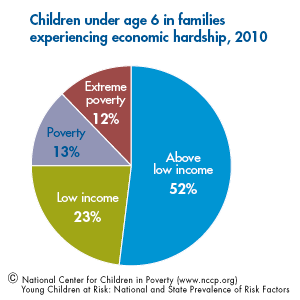
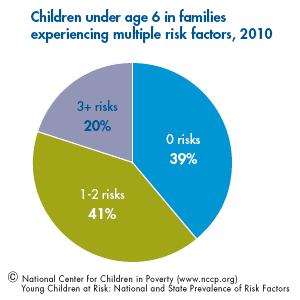
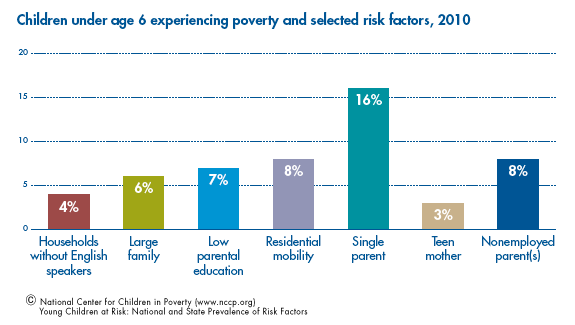
There are almost 24 million children under age 6 in the United States. Large numbers of young children are growing up in families experiencing economic hardship.
- Almost half – 11.4 million children – live in low-income or poor families.
- This includes 12 percent – nearly three million children – who live in extreme poverty.
Poverty, in combination with one of the seven risk factors included in the Young Child Risk Calculator, affects large numbers of children under age 6.
- Between three and 16 percent of young children are affected by poverty in combination with another risk factor, including parents lacking a high school degree (1.7 million), teen mother (almost 0.7 million) and living in a household without English speakers (0.9 million).
- Nearly four million children (16 percent) are living in families at or below the federal poverty level and headed by a single parent.
- Twenty percent of young children (over 4.7 million) are affected by three or more risk factors.
How does the prevalence of risks affecting young children vary across the states?
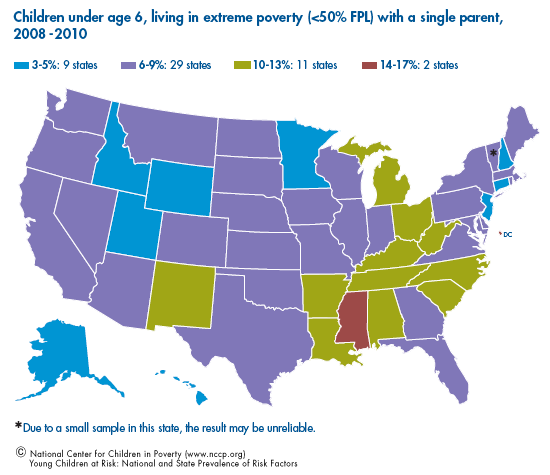
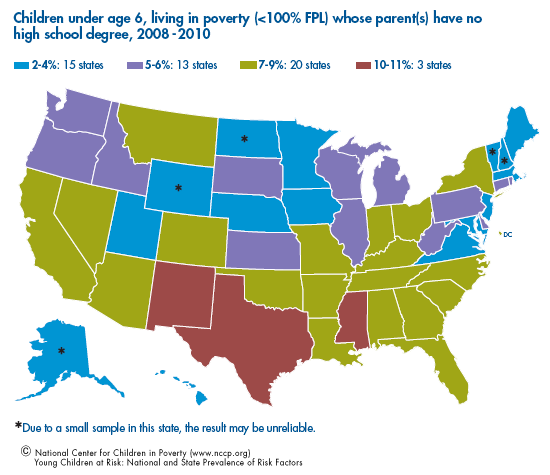
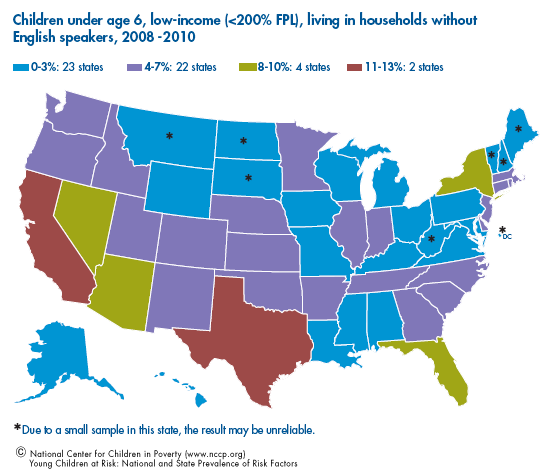
Mississippi and the District of Columbia have the highest percentages of young children living in extreme poverty in a single-parent household (15 and 17 percent, respectively).
- In three states (Mississippi, New Mexico and Texas), 10 to 11 percent of children under age 6 are living in poverty and have parents with no high school degree.
- Texas and California have the highest percentages of children (11 to 13 percent) who are low-income and living in households without English speakers.
Additional Resources
A range of state policies that address child health and development, early care and education, and basic supports for parenting and family economic security can reduce risks to children’s development and the negative impacts of poverty on children. NCCP’s Early Childhood State Policy Profiles provide information about each state’s policies in these areas and a national summary of state policies (see box).
Please contact us at ito@nccp.org if you would like NCCP’s assistance. We can provide:
- background information on policies and state trends, and reports and presentations (e.g. compare your state’s eligibility levels for child care to other states and national trends); and
- information about research on risk factors and implications for designing policies and targeting programs.
Early Childhood State Policy Profiles
To learn more about specific policies in each state that affect at-risk children, go to NCCP’s Early Childhood State Policy Profiles . The profiles show each state’s policy choices in the areas of health, early care and education, and parenting and family economic supports. For example, the user can see whether or not their state keeps copayments for child care subsidies below 10 percent of family income for families of three at 150 percent of the federal poverty level (FPL). Profiles can be used to assess and consider ways to strengthen current policy choices that can affect young children’s health, development and school readiness. This resource also provides information about trends in policy choices across the states.
Endnotes
National data were calculated from the 2010 American Community Survey, representing information from 2010. State data were calculated from the 2008-2010 American Community Survey, representing information from the years 2008 – 2010.
1. Evans, G. W. (2004). The environment of childhood poverty. American Psychologist, 59(2), 77-92.
2. Yeung, W. J., Linver, M. R., Brooks-Gunn, J. (2002). How money matters for young children’s development: Parental investment and family processes. Child Development, 73(6), 1861-1879.
Bradley, R. H., Corwyn, R. F. (2002). Socioeconomic status and child development. Annual Review of Psychology, 53, 371-399.
3. Halle, T., Forry, N., Hair, E., Perper, K., Wandner, L., Wessel, J. & Vick, J. (2009). Disparities in Early Learning and Development: Lessons from the Early Childhood Longitudinal Study – Birth Cohort (ECLS-B). Washington, DC: Child Trends.
4. Schlee, B. M., Mullis, A. K., Shriner, M. (2008). Parents social and resource capital: Predictors of academic achievement during early childhood. Children and Youth Services Review, 31(2), 227-234.
5. Pungello, E. P., Kainz, K., Burchinal, M., Wasik, B. H., Sparling, J. J., Ramey, C. T., Campbell, F. A. (2010). Early educational intervention, early cumulative risk, and the early home environment as predictors of young adult outcomes within a high-risk sample. Child Development, 81(1), 410-426.
Burchinal, M., Roberts, J., Zeisel, S. A., Hennon, E. A., Hooper, S. (2006). Social risk and protective child, parenting, and child care factors in early elementary school years. Parenting: Science and Practice, 6(1), 79-113.
